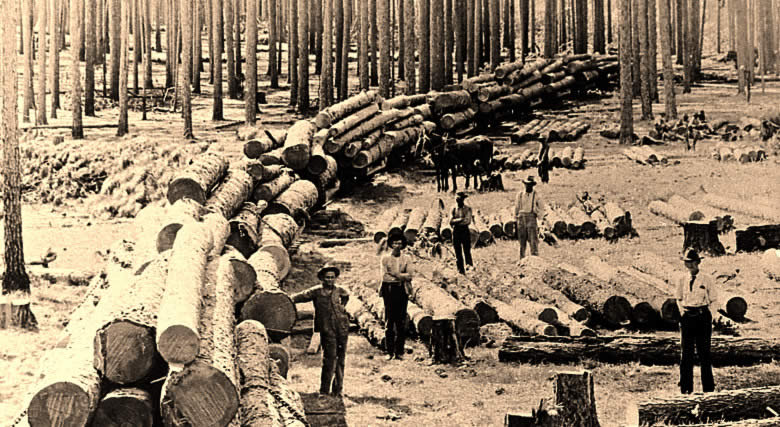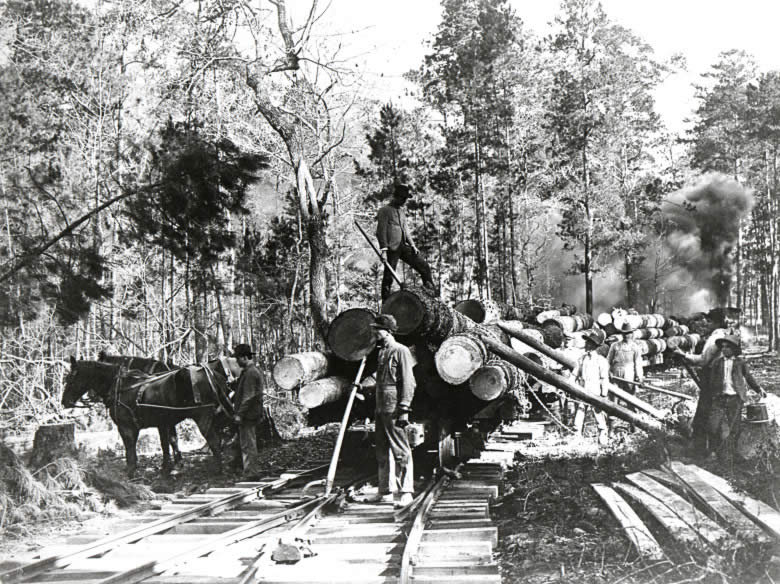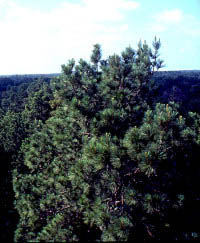
Long-leaf pine, one of the
several varieties of trees harvested by loggers
in East Texas.
|
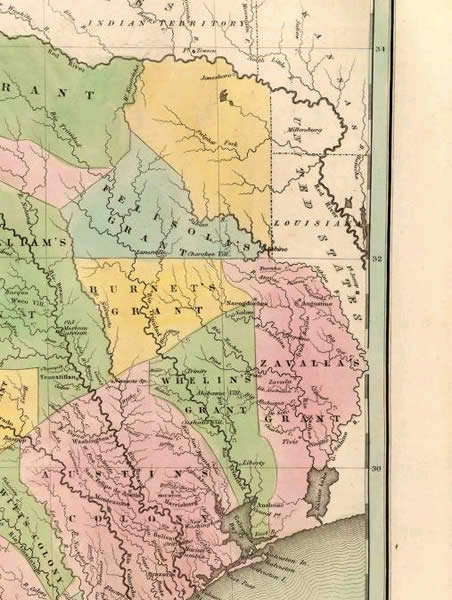
Land grants
in East Texas, circa 1838. In
Texas Republic days, land was
an attractant for settlers and
brought cash to the treasury.
In the decades following, vast
timber-laden tracts were accumulated
for lumber operations. Map by
Thomas G. Bradford, courtesy of
David Rumsey Historical Map Collection.
Click to enlarge.
|

Tall pines
stand sentinel at an old farmstead
south of Lufkin in East Texas.
Early settlers made only small
inroads into the vast forests,
building log cabins and farm buildings
and clearing fields for crops
and grazing. Photo by J. Griffis
Smith, courtesy Texas Parks and
Wildlife. Click to enlarge.
|

Thompson Lumber
Company office in Houston. What
was to become one of the major
lumber operations in East Texas
began in 1852 with John M. Thompson's
establishment of a small mill
in northern Rusk County. Photo
courtesy Stephen F. Austin State
University, Thompson Collection.
Click to learn more.
|
|
Settlers coming into East Texas in the
early 1800s encountered vast forests—pines and
hardwoods extending for miles in a verdant swath broken
only by murky, meandering rivers. Caddo Indians had
lived in these woodlands for thousands of years, felling
trees for their tall, beehive-shaped houses and temples
and constructing villages along the Red River, Neches
and Sabine. But their impact, and that of the Anglo
farmers who followed them, was light, and the forests
maintained their dominance on the land.
Commercial logging was
to alter that balance, and in the process
bring tremendous changes in the economic,
social, political, and environmental
composition of the region. Evolving
from small water-powered mills to massive
sawmill complexes and factory towns,
the logging business became the primary
focus of activity in the region and
lumber the lifeblood for various support
industries, from ports, railroads, equipment
suppliers, and mercantile companies
to family farms that supplied produce
to the growing sawmill communities.
Lumber Shortage
Amid Forests of Plenty
On March 1, 1836, Texas declared its independence
from Mexico and, through armed revolution, won its independence
on May 12, 1836. As a fledgling nation, Texas was without
any financial structure. In order to develop a treasury,
Texas sold its only commodity—land. This process
stimulated land entrepreneurs, or speculators, to treat
land as cash. Frequently a land grant was sold several
times prior to actual survey. Some people began to acquire
enormous landholdings, a factor that attracted corporate
investment in large sawmill operations several decades
later.
The first sawmill identified
with a specific individual is an 1829
mill on Carrizo Creek in Nacogdoches
County, built by entrepreneur and land
speculator Peter Ellis Bean. Bean exemplifies
the nature of the American frontiersmen
who settled Texas. He first entered
Texas in 1801, hunting horses and trading
with Indians along the Brazos River,
at a time when it was still under Spanish
rule. He built a water-powered, sawmill
(sash saw) and gristmill and also ran
a lumberyard in Nacogdoches. Attracted
by that success, other logging entrepreneurs
began operations in Texas.
In the decades before the Civil War, however,
transportation was a continual problem. Due to the natural
obstacles of rivers and muddy soils, few overland roads
were suitable for travel at all times, particularly
in East Texas. Rivers, which formed the backbone of
commerce in the United States, were erratic in water
flow and became clogged with logs, snags, and silt.
Sawmill owners in the East Texas interior were forced
to settle for local trade combining a grist mill and/or
general merchandise store, while coastal lumbermen had
developed a considerable export trade worldwide.
The centers of commerce
developed along the Gulf Coast, where
marine shipping could interface with
riverine steamboats and overland wagon
haulers. Logging rafts, keelboats, and
later steamboats operated only during
optimal river flow conditions. Due to
this lack of transportation, the vast
pine forests of East Texas could not
be fully exploited in a profitable manner.
Consequently, despite the abundance
of standing timber, there was a chronic
shortage of lumber within Texas.
The Bonanza
Period: 1876-1917
|
|
In this section:
|

Caddo Indians, the first settlers
in the Piney Woods, used poles made from young
pine trees to construct their houses and temples.
In this artist's depiction of a scene around 800
years ago, teams of Caddo builders set tall, flexible
poles in a circular frame for a large, dome-shaped
house. Painting by Nola Davis, courtesy Texas
Parks and Wildlife Department, Caddo Mounds State
Park. Click to enlarge.
|

The Great Raft, a massive logjam
in the Red River. Natural obstacles such as this
blocked transportation on rivers in East Texas,
heightening the need for improved transportation
on land. Photo courtesy of Louisiana State University,
S. Noel Collection.
|
|
The logging business became
the primary concern in the region
and lumber the lifeblood for various
support industries, from ports,
railroads, equipment suppliers
and mercantiles to family farms
that supplied produce to the growing
sawmill.
|
|
|
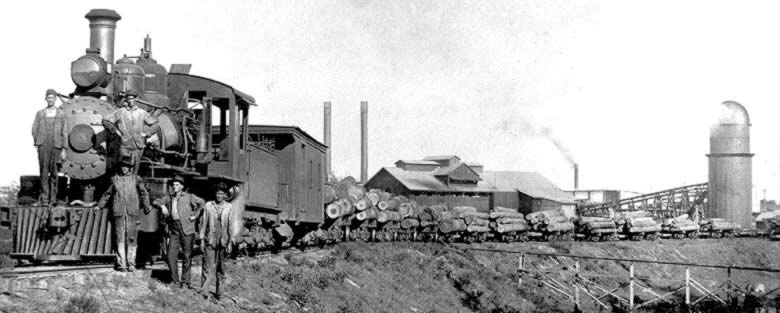
Texas and South-Eastern Railroad log train
at Diboll, circa 1910. The completion of a railroad network
in East Texas and across the state—enabling transport
of wood products from forests to mills and beyond—was
a key factor fueling the Bonanza Period of logging. Photo
courtesy The History Center, Diboll.
|
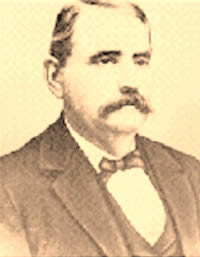
Henry J. Lutcher.
The lure of land drew the Pennsylvania
lumberman and his partner, G.B.
Moore, to Texas in the 1870s.
Lutcher and Moore constructed
a "state-of-the-art" sawmill at
Orange and purchased timberland
on both sides of the Sabine River.
The two later built three railroads:
the Gulf, Sabine, and Red River;
the Mississippi and Ponchartrain;
and the Orange and Northwestern.
|
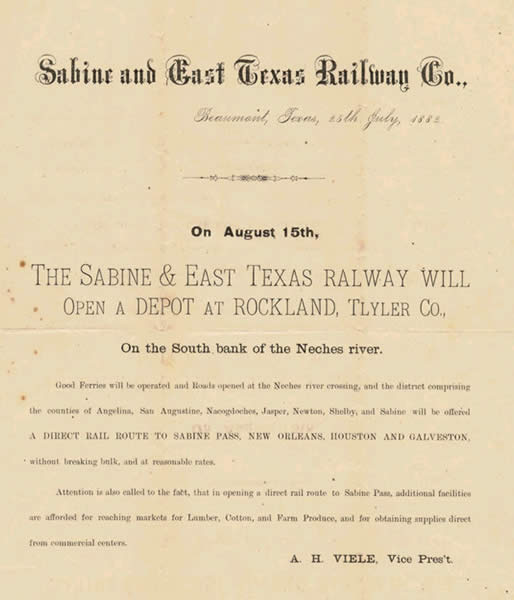
Flier for the
Sabine & East Texas Railway, 1882.
The company, later incorporated
into the Texas and New Orleans
line, was one of many short, trunk
lines constructed by mill owners
during the Bonanza period to move
lumber products. Photo courtesy
"Texas Tides" digital historic
photo collection, Stephen F. Austin
State University. Click to enlarge.
|

Thomas Lewis
Latane Temple (1855-1935) founded
Southern Pine Lumber Company in
1893, Texas South-Eastern Railroad
in 1900, and Temple Lumber Company
in about 1906. The Southern Pine
and Temple companies merged in
1956 and are now known as Temple-Inland
Forest Products Corporation. Photo
courtesy of The History Center,
Diboll.
|
|
The Civil War halted settlement
and economic growth in East Texas. Investment
in transportation began again after
the war, particularly due to the liberal
policies of the State, which granted
land to rail companies for each mile
of track they lay. By 1880, railroad
development had reached a point where
main lines connected most of East Texas.
At this time a new innovation, the band
saw, also arrived, enabling safer and more efficient
milling operations. Concurrently, the forests of the
Great Lakes were being cut out, and investment capitalists
were turning their attention to the forests of the south,
and Texas in particular. This marked the beginnings
of an enormous period of growth for Texas logging and
the rise of the big mills. Again, land speculators combed
through the courthouses and land districts of East Texas,
acquiring lands that were unclaimed or available for
back taxes and putting together some of the largest
tracts to date in Texas.
In "Sawdust Empire," Robert
S. Maxwell and Robert D. Baker describe this period,
ranging roughly from 1876-1917, as the "Bonanza
Period" of the logging industry in East Texas.
It was during this period that fortunes (both personal
and corporate) were made. The larger mills that had
been established earlier in the period grew larger and
more powerful, while many of the smaller mills as well
as some of the large mills that had come too late into
the region, suffered from a lack of access to timber
and were forced out.
The Bonanza Period of industrial logging
would never have occurred were it not for the introduction
of the railroad to the forests of East Texas in the
1880's. Prior to that time, transporting cut timber
to the mills was a slow, tedious endeavor dependent
upon draft animals, good weather, and good fortune.
Initially logging was performed close to rivers, where
water was used to ship the cut and seasoned logs to
the mill. Staging areas were located at central areas.
The logger cut the trees with an ax, using a saw to
cut the tree to lengths. The trees were dragged by oxen
or mule to the river bank where they were stacked awaiting
high water. Once in the water the logs were joined into
rafts, and floated to coastal mills.
The advent of steam-powered,
small-gauge trains and loaders made
it possible to transport ever larger
loads of logs to the mills. Once the
railroad was extended into the interior,
mills were constructed closer to the
remaining virgin stands. Corporations
built much larger mills along rail spurs
in the remaining uncut areas of East
Texas.
In the Woods
Trees were selected, felled,
scaled, and cut to transportable size
by timber crews , usually 40 to 60 men
supervised by a woods boss, known also
as the "bull of the woods."
Conditions were often grueling, with
workers putting in 10-hour days on back-breaking
tasks in the forests, often many miles
from the mill. Many experienced loggers
were expert at their trade, able to
notch, saw, and fell a tree with precision.
In addition to cutting tasks, forest
workers transported logs, worked on
roads, and set miles of ties for rail
tracks.
|
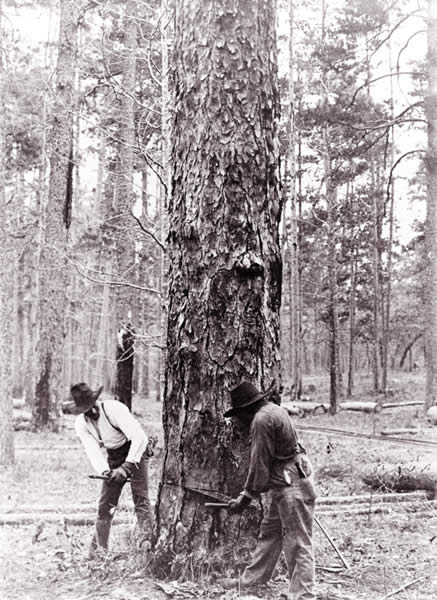
Two sawyers
use a crosscut saw to cut down
a large pine. Photo courtesy Center
for American History, University
of Texas at Austin. Click to enlarge.
|
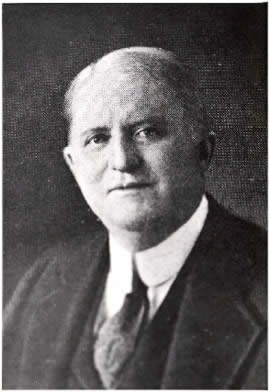
John Henry
Kirby, the "Prince of the Pines,"
shown in a 1925 photo. Kirby built
a railroad, oil company, and lumber
company, at one point controlling
more than 300,000 acres of land,
but was forced into bankruptcy
during the Depression. Photo courtesy
of the Center for East Texas Research,
Stephen F. Austin State University,
Forest History Collection. Click
to learn more.
|
|
|
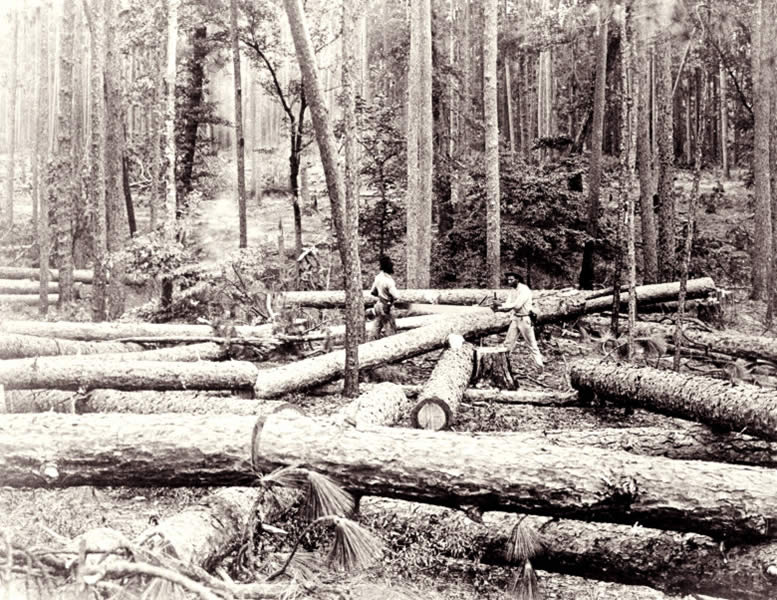
"Buckers,"
or choppers, saw pine trees, which
have been stripped of branches, into
smaller sized-logs for transport.
Photo, circa early 1900s, courtesy
of Center for American History, UT-Austin.
Click to enlarge.
|

The woods boss,
or "bull of the woods,"
looks on as a scaler evaluates the
size of a log. The boss wielded considerable
authority: when a worker got into
a confrontation with the boss, it
was said that he had "locked
horns with the bull." Photo,
courtesy of Center for American History,
UT-Austin. Click to enlarge.
|

An enormous log
is loaded on a high-wheeled cart,
ready to be pulled by mules to a flatcar
for transport to the mill. Photo,
courtesy of Center for American History,
UT-Austin. Click to enlarge.
|
|
|
Logging workers, hauling
hundreds of yards of cut timber, emerge from a partially
cut forest in East Texas. Photo courtesy Center for
American History, UT-Austin. Click to enlarge.
|
Early cross-loading
operation using mules to haul logs onto a flatcar. The
later introduction of steam-powered cranes to hoist
the logs revolutionized the logging industry. Photo
courtesy Center for American History, UT-Austin. Click
to enlarge.
|
|
Mills and Mill Towns
|

A train carries a load
of logs to the Thompson Brothers mill. The
logs were floated into the mill pond for storage
or guided by a "pond monkey" onto a chain
and into the mill for processing. Photo courtesy
of Center for American History, UT-Austin,
East Texas Photograph Collection, (DI#01287).
|

Workers stand
by as logs pass down a conveyor
belt in this early 20th-century
sawmill. Photo courtesy of USDA
Forest Service. Click to see full
image.
|

A sawmill worker
checks a load a lumber ready for
shipping. Photo courtesy of Stephen
F. Austin State University, Forest
History Collection.
|
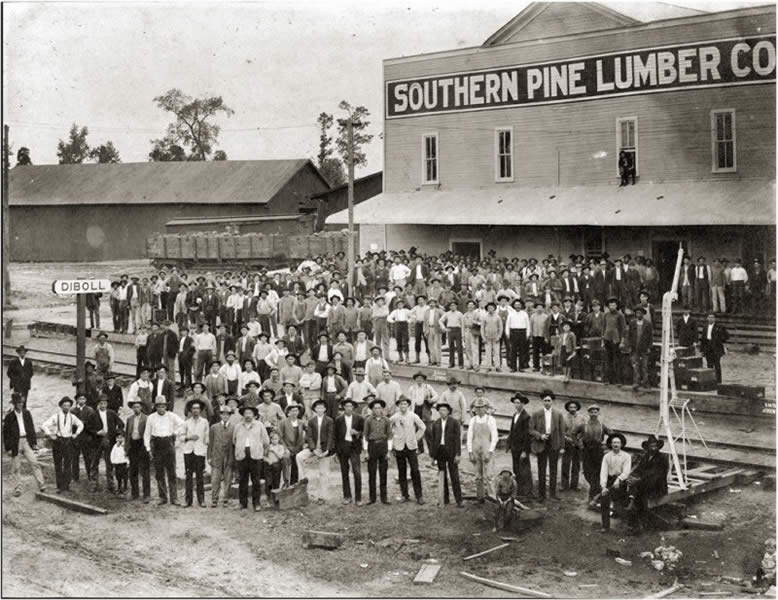
Employees of
the Southern Pine Lumber Company
in front of the company store,
or commissary at Diboll, about
1907. Photo courtesy of The History
Center, Diboll.
|

Children walk
along the railroad tracks at the
Diboll sawmill ponds in about
1912. Their parents were managers
at the Diboll commissary and the
planing mill. Click to enlarge.
Photo courtesy of The History
Center, Diboll.
|
|
During the Depression, the
Southern Pine Lumber Company was
forced to sell about 100,000 acres
for less than $3 an acre to keep
its sawmill working. Many Diboll
employees repaid the loyalty the
company had shown them by lending
the company small sums of money
they had managed to save.
|
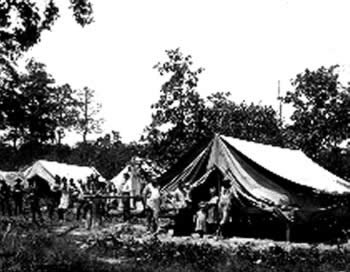
A "front camp"
in the forest. Wood crews-flatheads,
skidders, loaders, and others--often
worked miles away from the sawmills,
making it necessary to set up
temporary living facilities for
workers and their families. Small
towns of tents or boxcars were
common in the woods. Photo courtesy
of Stephen F. Austin State University,
Thompson Collection. Click to
enlarge.
|
|
By 1910 there were more
than 600 sawmills in Texas, although
probably no more than 100 could be considered
large mills—those with a capacity
of 80,000-100,000 board feet. In many
areas, the sawmill represented the only
source of cash, and two or three generations
often worked in turn at the mill. The
mill created work where none had been
available, and the owners had to provide
housing, usually deducted from pay.
In terms of operations,
one of the most important features of
the mill was the mill pond. It covered
several acres and could hold up to four
million board feet of logs. The water
provided ease of loading and unloading,
preserved the logs from bark beetle
attacks, and washed dirt and soil off
the logs, thus reducing wear on the
saws. From the pond, the logs were moved
onto a conveyor chain, and were hauled
to the log deck. If no pond was available,
rail tracks were placed as a siding
as close to the saws as possible.
A typical large sawmill
was a complex of two or three story
buildings divided according to each
step of the lumber-making operation.
The saw machinery usually was located
on the second floor, the saw filer,
who kept the saws sharpened, on the
third floor. On the second floor, the
scaler measured and sized the log, using
the cutoff saw to section the long timber
into efficient cutting lengths. Moved
via a log kicker, logs were then sent
to bandsaws, where the sawyer cut the
log into boards. Once trimmed, the lumber
was transported into the yard to dry
and cure before it was finally sent
to the planer for final processing.
With the growth and expansion
of mills came company towns, the small
communities which were to dominate the
landscape and economy of East Texas.
The company town typically was isolated,
placed near the critical resources—large
tracts of timber. As trees were cut
down and forests used up, logging operations
moved into more-remote areas, and more
towns built. It was not uncommon for
towns of a thousand people or more to
spring up in a year's time.
Mill towns were composed
of segregated groups of houses for black
and white workers and their families,
a general store or commissary, a hotel/boarding
house, company offices, churches, schools,
and stores. In most towns, water was
pumped from a well for two or more houses;
indoor plumbing and electricity became
available in some areas in the late
1920s. Most homes had gardens and a
few chickens kept in pens or ranging
free in the yards. Wood cook stoves
and potbellied stoves provided heating
and served for food preparation.
Mill towns varied as to
amenities and comforts. While Fostoria,
a milltown owned by the Foster Lumber
Company of Kansas was described as clean,
well-kept, and self-sustaining, Kirbyville,
owned by the Kirby Lumber Company, was
characterized by a visiting Harper's
Weekly journalist as "gray
dingy boxes arranged row by row in the
horror of dull uniformity that is the
curse of most industrial communities."
Generally, the larger and more influential
mill owners, such as Lutcher and Moore,
T.L.L. Temple, the Thompson Brothers,
and Carter-Kelly companies, were responsible
for the more well developed and advanced
mill towns, with electrical power and
running water available to most, if
not all, mill town residents.
In some towns, deep bonds
were formed between company and workers.
During the Depression, the Southern
Pine Lumber Company was forced to sell
about 100,000 acres for less than $3
an acre to keep its sawmill working.
Many Diboll employees repaid the loyalty
the company had shown them by lending
the company small sums of money they
had managed to save.
In addition to mill towns,
the East Texas forests were dotted with
temporary camps and make-shift towns
for the workers in the woods—those
involved in cutting and harvesting trees
and making wood products. There were
front camps, often constructed along
rail trams as staging areas for workers;
turpentine camps, where pine resins
were harvested and made into turpentine;
tie camps where railroad ties were collected
and shipped; stave camps, where barrel
staves were made; tent camps along railroads
or in remote settings; and the cutting
front itself. Boxcars and tents typically
served as housing for the forest workers.
These facilities were
usually established next to the main
lines of the logging railroads, which
connected them with the primary mill
and its mill town. These logging railroads,
or trams, provided not only the principal
means of carrying cut timber to the
mill, but also functioned as a basic
transportation system for the front
camp workers, who usually had families
living in the primary mill towns. These
trams were extended as the logging fronts
advanced through the virgin pine forests,
often resulting in an intricate spiderweb
design of cleared routes that would
eventually become the basis for a fully
developed rural transportation system
of Farm-to-Market and County Roads.
Without this infrastructure, the modern
development of East Texas would not
have been possible.
After the Boom
|

Interior of
an early 20th-century sawmill.
Photo courtesy Center for American
History, University of Texas at
Austin. Click to see full image.
|

Lumber planks
are loaded into boxcars for distribution
in this 1907 scene at the Diboll
mill. Photo courtesy of The History
Center, Diboll.
|

A family poses
on the front porch of their company
house in a milltown. Housing provided
by lumber companies varied from
town to town; this board-and-batten
cottage would have been considered
quite comfortable. Click to enlarge.
Photo courtesy Stephen F. Austin
State University, Forest History
Collections.
|
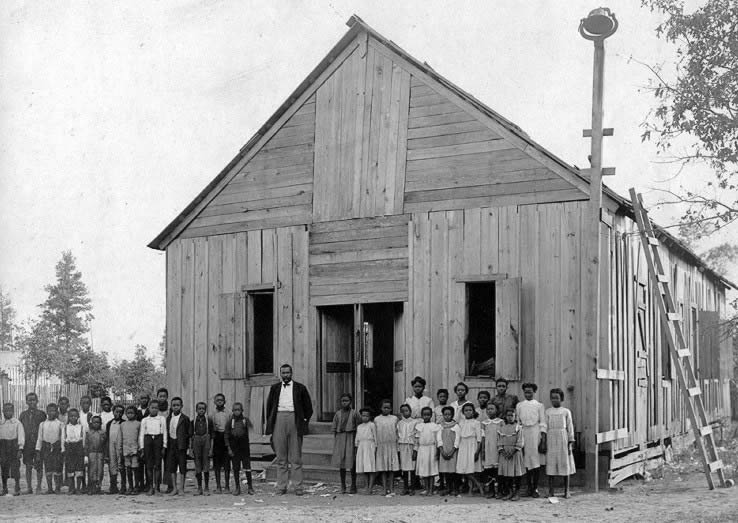
Pupils gather
with their teacher in front of
the Diboll school house, circa
1907. Many milltowns had both
segregated schools and residential
areas. The teacher in the photo
is identified as J.W. Hogg. Photo
courtesy The History Center, Diboll.
|

A child poses
on the cowcatcher of Temple Lumber
Company train engine No. 6, with
its crew. Transporting both logs
and timber workers from forests
to milltowns, trains and forest
trams were a vital connection
for the logging business in East
Texas. Photo courtesy of The History
Center, Diboll.
|
|
|
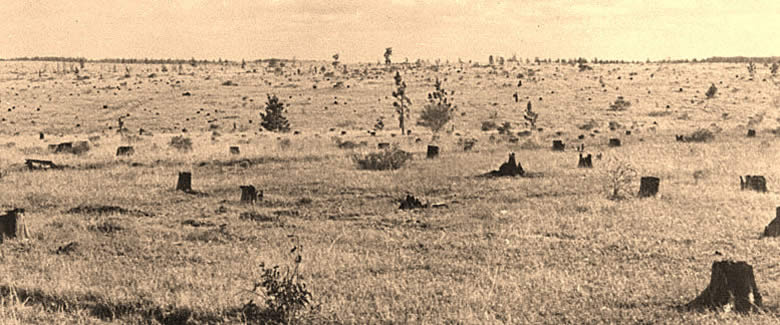
Tree stumps dot the rolling
landscape where tall pines once stood. Since
the time of this circa 1902-1908 photo, much
of the deforested land has been purchased
by the USDA Forest Service and replanted.
Photo courtesy of the center for American
History, UT-Austin (#DI-01295).
|

William G. Jones, a banker
from Temple, Texas, helped establish Arbor Day
and The Texas Forestry Association with the purpose
of replanting trees. He later petitioned President
Franklin Roosevelt for forest and wildlife reserves
on cutover lands, an effort which led to the National
Forests in Texas. Photo courtesy of Stephen F.
Austin State University, Forest History Collection.
|

A branch of
a young pine tree. Trees planted
by the USDA Forest Service and
East Texas lumber companies in
cut-over areas have grown into
mature forests in many areas.
Photo by Elizabeth Grivas, courtesy
of Texas Department of Transportation.
|
|
In 1917, Robert W. Wier
and the Lutcher and Moore heirs combined
resources to construct the last large
mill at the town of Wiergate, with timberlands
covering about 86,000 acres in Newton,
Jasper, and Sabine counties. The Wiergate
Lumber Company logged what was perhaps
the last great Texas stand of longleaf
pine.
By 1920, many of the lands
acquired by the big mills had been cut
out, leaving tangled thickets of second
growth hardwoods, mixed with a few pine
seedlings. Foresters and conservationists
complained that the practice of free-range
husbandry eliminated pine regeneration
and promoted the growth of hardwood,
thereby eliminating the potential for
sustained yield logging. Some companies
moved to the West Coast, where large
tracts of lands and forest were available
to sustain the cut-and-run method of
logging. Others went bankrupt, letting
their lands fall into receivership.
Because Texas had retained
its public lands when it became a state
in 1845, the federal government lacked
national parks and forests in the state.
In May 1933, the Texas legislature passed
a bill, supported by both lumbermen
and conservation groups that authorized
the U.S. Forest Service to appraise
and purchase lands. The federal government
purchased more than 90% of the lands
that were to comprise the National Forests
in Texas from 11 lumber companies.
Beginning in 1898, the
Forestry Bureau of the U.S. Department
of Agriculture began an agreement program
with Texas lumber companies and private
individuals to develop working plans
to restore the forests and develop a
sustained yield strategy. From the 1930's
to the present, the U.S. Forest Service
has replenished the East Texas forest
reserves and developed effective sustained
yield practices, while conserving soil,
water, and other natural resources.
The cultural, social and
economic structures for modern East
Texas were shaped and molded by the
early 20th century logging industry.
Mill towns have become cities; logging
railroads have become multi-lane highways;
and family-owned mills have become multi-national
corporations, all in the last 100 years.
There are few, if any, facets of modern
East Texas that have not been directly
affected, or influenced, by the boom-bust
cycles of the early 20th century logging
industry.
Tracking Historic Sites in the Texas National Forests
|
|
It is rare now to find a good
body of pine standing along the
railroad, the best must be sought
ten and fifteen miles back . .
. The hope of the forests is that
the State or the United States
government will intervene, and
pass laws limiting the cut to
certain sizes, also employing
a forestry patrol to guard against
fires and waste.-William Goodrich
Jones, following a horseback survey
of the East Texas pine forests
in 1898.
|
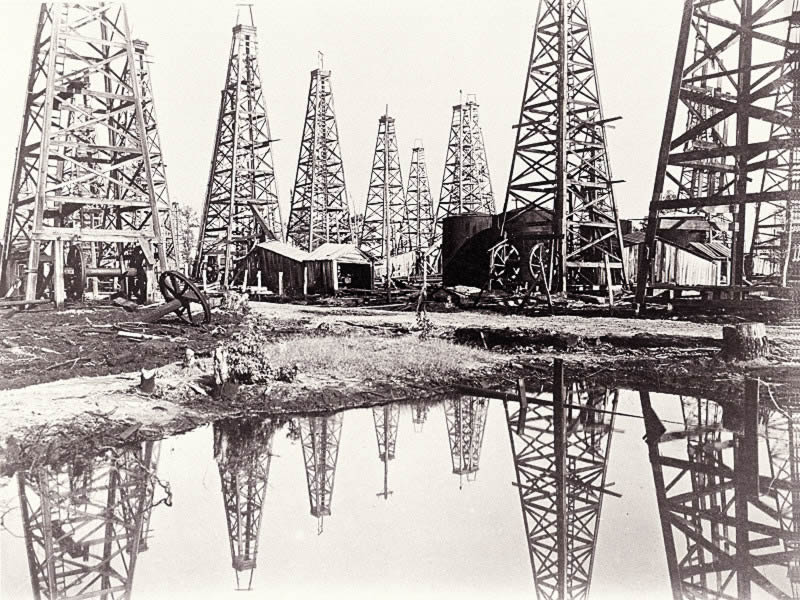
Wooden derricks are reflected in
an oil field pond at Sour Lake,
Texas. Lumber from East Texas provided
building materials for industries
across the state, from oil derricks
to rail ties. Photo courtesy of
Center for American History, University
of Texas at Austin. Click to enlarge. |
|
|
| |
East Texas Sawmill
and Rail Data Bases
|
|
Counties
|
# of Mills
|
# of Trams &
RRs
|
|
Angelina
|
178
|
34
|
|
Houston
|
151
|
9
|
|
Jasper
|
98
|
25
|
|
Montgomery
|
272
|
35
|
|
Nacogdoches
|
272
|
25
|
|
Sabine
|
98
|
9
|
|
San Augustine
|
217
|
16
|
|
San Jacinto
|
86
|
6
|
|
Shelby
|
273
|
10
|
|
Trinity
|
37
|
19
|
|
Walker
|
125
|
19
|
|
|
|
|
The remains of the early
20th-century logging industry which
can be found in the four National Forests
in Texas represent the full range of
logging industry-related sites and features.
Major mills and mill towns, such as
Aldridge and 4-C, represent the highest
level of development, with multiple
saws, large residential areas, commissaries,
hotels, schools, churches, and other
conveniences one would expect in a small
community. Smaller front camps, such
as Bannister, Brittain, Wilburn and
Ragtown, while smaller and only temporarily
occupied, contain equally complex features
as the larger mill towns. These essentially
mobile encampments were laid out in
a precise pattern with primary and intersecting
secondary thoroughfares lined by tents
or other types of temporary housing.
In 1993, the Texas Forestry Museum began
development of a database of historic sawmills in the
twelve county area defined as the Deep East Texas Council
of Governments. The Museum was joined in this development
by the T.L.L. Temple Archives, the Sam Houston Regional
Library, the USDA Forest Service and the School of Forestry
at Stephen F. Austin State University. By the end of
1994, over 5,500 sawmills and logging industry related
sites, located in forty counties from the Red River
to the Gulf Coast in the eastern third of Texas, were
listed on the database. By the end of 1995, a linked
database of Steam Logging Rail Roads had been also been
developed. In 1998, the sawmill database was made available
to the general public through the Texas Historic Sites
Atlas Project, Texas Historic Commission and Texas Archeological
Research Laboratory.
|
To learn more about historic logging
sites in the Texas Pineywoods, search
the online East Texas Sawmill Data Base©
and East Texas Tram and Railroad Data
Base© developed by the Texas Forestry
Museum and maintained by the Texas Historical
Commission. The sawmill data base documents
more than 4500 sites in 54 counties,
and the tram data base details more
than 300 trams and railroads that were
run as sawmill company lines. These
sites may be researched on the Texas
Historical Commission's Historic
Sites Atlas.
|
|
|
